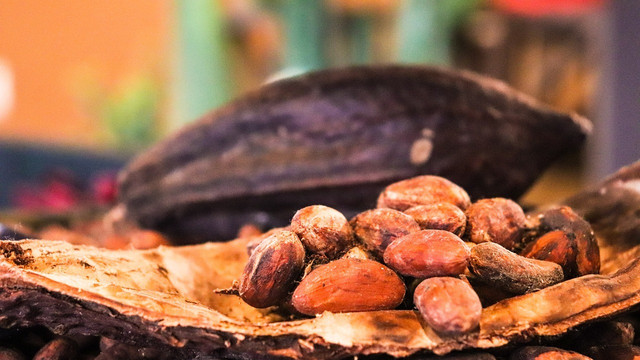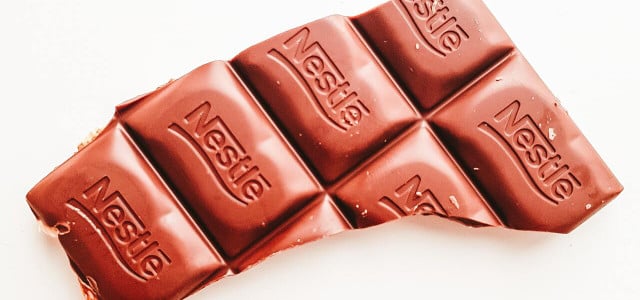Where does chocolate come from, and why does it matter? From a sacred Mayan food to a global commodity, discover the history of chocolate — a treat once worth its weight in gold!
Although chocolate now takes many forms, from candy bars to powdered hot chocolate, the early versions were a far cry from the sweet, milky chocolate many of us enjoy today.
While chocolate can be found across the globe, many people don’t know how or where it’s made. So where does chocolate come from, exactly? Despite names like “Belgian” or “Swiss” chocolate, this treat did not originate in Europe. The history of chocolate dates back four thousand years and has its roots in South America and Mesoamerica.
If you’re wondering where chocolate comes from, keep reading to learn more about its complex history and how it’s made today.
Where Does Chocolate Come From?

(Foto: CC0 / Pixabay / allybally4b)
Before we find out where chocolate comes from, let’s learn what it is. Chocolate is made from the seeds of the Theobroma cacao tree, which thrives in tropical climates and can grow up to 40 feet tall. The tree produces long, acorn-shaped pods which house cacao seeds. While most modern chocolate is from the Theobroma cacao species, Indigenous people of South and Central America and Mexico use many different species of Theobroma trees in their food, drink, and medicine.
The cacao tree was first domesticated about four thousand years ago in the Amazon basin before being brought to Central America and Mexico. Today, cacao trees are grown worldwide, primarily in climates near the equator. Much of the world’s cacao is now grown across Africa, Asia, and Central and South America.
Before the cacao seeds — sometimes called cacao beans or cacao nibs — can be eaten, they must undergo a lengthy process of fermentation to remove some of their bitterness. The seeds are then dried, roasted, and ground into a thick brown paste, which can be used in a variety of chocolate products. Most conventional chocolate is made from a combination of this paste, a fat (such as cocoa butter), and powdered sugar. During the production process, cacao butter, cacao paste, and raw cacao can also be separately extracted from the seeds.
To understand where chocolate comes from, we must differentiate between cacao, cocoa and chocolate. “Cacao” refers to the cacao seeds or cacao powder before processing. This is pure cacao without any additives and is quite bitter. “Chocolate” refers to products made from cacao beans in liquid or solid form. “Cocoa” refers to chocolate in its powdered form, and it often already has sweeteners added.
Various classifications are used to distinguish the different kinds of chocolate, all based on their cacao contents:
- Raw chocolate is most often sold in cacao-growing countries and contains cacao, which has not been processed, heated, or mixed with other ingredients and is thus bitter and robust.
- Dark chocolate usually has no milk content and contains between 70 and 100% cacao.
- Milk chocolate contains milk, and its cacao content ranges.
- White chocolate is made of sugar, milk, and cocoa butter without any ground cacao.
The History of Chocolate



(Foto: CC0 / Pixabay / gnr588)
While Europe is famous for creamy, sugar-filled chocolate bars, it was the Indigenous civilizations of South America, Central America, and present-day Mexico that first cultivated the Theobroma genus — the source of cacao seeds used to make chocolate. As far back as four thousand years ago, the Amazon basin and Central America were home to these early cacao cultivators. In fact, some of the earliest known people to cultivate cacao lived around 3000 BCE in the Andes regions of Ecuador and Peru.
A significant milestone came when the pre-Olmec people in what is now Mexico made a cacao beverage with vanilla and chili peppers around 2000 BCE. Millennia later, the Maya believed chocolate to be a highly valued drink of the gods, drinking it as a hot beverage with other ingredients like chili, water, and cornmeal to create a frothy texture.
The Aztecs similarly believed chocolate to be a gift from the god Quetzalcoatl and drank it as a cold beverage. In their language, called Nahuatl, they named it “xocolatl,” meaning bitter water. This is where we get the word chocolate from. They even used it as currency at some points, highlighting its value in their society. Today, in various areas of South and Central America, people continue to spice their hot chocolate with vanilla, chili, allspice, honey and more, keeping these traditions alive.
Despite the association of European countries like Switzerland and Belgian with chocolate, cacao was only brought to Europe in the 1500s due to Spanish exploration and colonization of the Americas. Over time, Europeans mixed cacao with sugar and honey, and it eventually became the product we know today.
While the European style of chocolate may be the most well-known today, it’s important to remember the rich history of chocolate that stretches back thousands of years.
The Chocolate Industry Today



(Foto: CC0 / Pixabay / 5671698)
The chocolate industry is a global, multibillion-dollar enterprise that involves the production, processing, and distribution of chocolate products. It is largely dominated by a few large companies, such as controversial Nestle, Mars, and Mondelez, which control a significant portion of the market share.
Though chocolate is one of many foods from the Americas that was brought to Europe, Africa, and Asia through colonization and trade, the present-day chocolate trade reflects old power dynamics from colonization and the height of the slave trade. Simply put, once chocolate’s popularity took off in Europe, demand was met by producing chocolate with the labor of enslaved Africans in Latin America and later in West Africa.
The production of chocolate involves a complex supply chain that spans from the farmers who grow cocoa beans to the manufacturers who process the beans into chocolate products. Unfortunately, this supply chain has been plagued by issues such as child labor, poverty, and environmental degradation.
Today, most chocolate is produced in Europe, although the majority of it is grown in West Africa. Europeans are the biggest consumers of chocolate today. Moreover, while West Africa grows 70% of the world’s cacao, the continent consumes only 4% of the world’s chocolate.
These inequalities don’t even begin to explain the truly dark sides of chocolate. The cocoa industry has been exposed for its reliance on child labor and modern slavery. There have been instances of such abuses in cocoa farms in West African countries as well as plantations in Brazil. Other cacao-growing regions are suspected of child and slave labor, but these human rights violations are often difficult to uncover.
In addition to these controversies, cacao plantations are known for their harsh labor conditions, as most work is done by hand, sometimes using dangerous tools like machetes. The likelihood of chemical exposure and other poor conditions, such as little food, low pay, and poor sanitation facilities — or a lack thereof — also prevail.
In recent years, a growing movement towards fair trade chocolate has emerged, aimed at promoting social and environmental sustainability throughout the supply chain. Fair trade chocolate is produced under specific guidelines that ensure farmers receive fair prices for their crops, workers are paid fair wages, and environmental sustainability is prioritized.
Organizations such as Fairtrade International have been established to promote fair trade practices in the chocolate industry. They work with farmers, cooperatives, and manufacturers to ensure that fair trade standards are met, and products are properly certified.
It’s important to note that not all chocolate on the market is fair trade. Consumers can look for fair trade certification labels on chocolate products to ensure they support ethical and sustainable practices in the chocolate industry.
Read more:
- Is Dark Chocolate Vegan? What You Need to Watch Out For
- Neither Nestlé nor Shell: This Is the Worst Company in the World
- Why Drink Fair Trade Coffee? Separating Fact From Fiction
Do you like this post?








